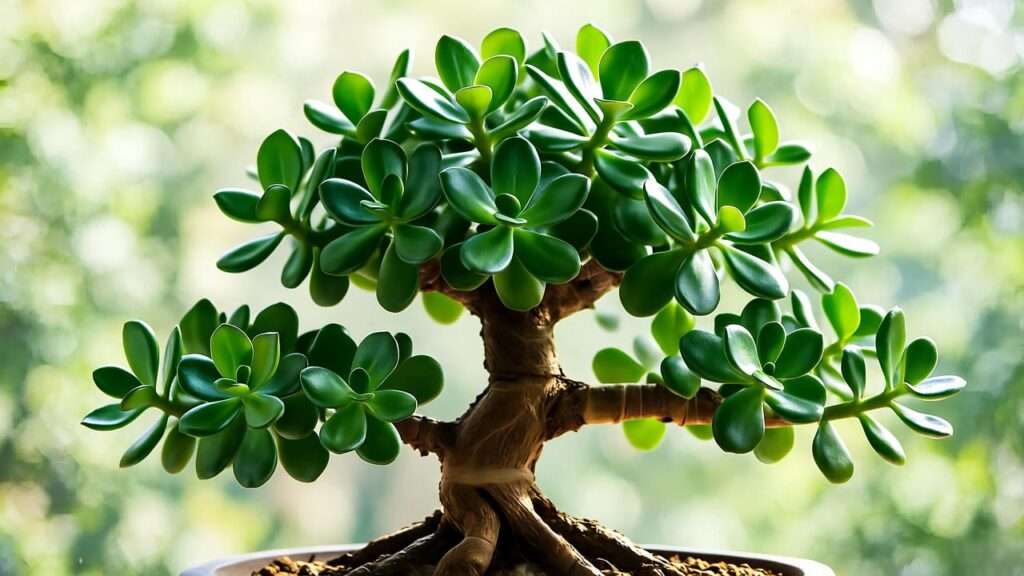Imagine a tiny, sculptural tree that brings a touch of serenity and prosperity to your home, all while requiring minimal fuss. That’s the magic of a jade plant bonsai! Known as the “money plant” for its lush, coin-like leaves and symbolic ties to wealth, this charming succulent is a beginner’s dream and a bonsai enthusiast’s delight. Whether you’re new to plant care or a seasoned grower, mastering jade plant bonsai care unlocks a world of aesthetic beauty and rewarding cultivation. In this comprehensive guide, we’ll walk you through every step to grow and maintain a thriving jade bonsai, from selecting the perfect plant to shaping it into a miniature masterpiece. Get ready for expert tips, practical solutions, and all the know-how to make your jade bonsai flourish! 🌟
1. What Is a Jade Plant Bonsai? 🌵
1.1 Understanding the Jade Plant (Crassula ovata)
The jade plant, scientifically known as Crassula ovata, hails from South Africa’s arid regions, where its thick, glossy leaves store water to survive dry spells. This resilience makes it an ideal candidate for bonsai cultivation. Its naturally compact growth, woody stems, and vibrant green foliage mimic the appearance of a miniature tree, even without extensive training. Jade plants grow slowly, which is perfect for bonsai enthusiasts who want to craft a lasting masterpiece without constant upkeep.
1.2 The Art of Bonsai with Jade Plants
Bonsai is the ancient Japanese art of growing miniature trees in pots, balancing aesthetics and horticultural skill. Jade plants fit seamlessly into this tradition due to their adaptability and forgiving nature. In many cultures, jade bonsai symbolize prosperity, longevity, and good fortune, earning them the nickname “money tree.” Common bonsai styles for jade include informal upright (moyogi), cascade (kengai), and multi-trunk designs, each showcasing the plant’s unique structure. Whether you’re drawn to the art or the symbolism, a jade plant bonsai is a rewarding project.
2. Benefits of Growing a Jade Plant Bonsai 🌟
Why choose a jade plant bonsai? Beyond its striking appearance, this succulent offers a host of benefits:
- Aesthetic Appeal: Its plump, jade-green leaves and sculptural form add elegance to any space, from minimalist apartments to cozy offices.
- Low Maintenance: Perfect for beginners, jade bonsai thrive with minimal watering and care.
- Air Purification: Like many succulents, jade plants improve indoor air quality by filtering toxins.
- Cultural Significance: In Feng Shui, jade plants are believed to attract wealth and positive energy.
- Longevity: With proper care, a jade bonsai can live for decades, becoming a cherished heirloom.
3. Choosing the Right Jade Plant for Bonsai 🌿
3.1 Selecting a Healthy Jade Plant
To start your jade bonsai journey, choose a healthy Crassula ovata with vibrant, unblemished leaves and a sturdy, woody stem. Avoid plants with yellowing leaves, soft stems, or signs of pests like mealybugs. Look for a specimen with a thick trunk or balanced branch structure, as these traits lend themselves to bonsai styling. You can find quality jade plants at local nurseries, garden centers, or reputable online retailers.
Pro Tip: A plant with a naturally stocky base is easier to shape into a bonsai than a leggy, thin one.
3.2 Propagating Your Own Jade Plant Bonsai
Want to grow your jade bonsai from scratch? Propagation is simple and rewarding! Here’s how:
- Choose a Cutting: Snip a healthy stem (4–6 inches long) or a plump leaf from a mature jade plant.
- Let It Callus: Allow the cutting to dry for 1–2 days until the cut end forms a callus.
- Plant in Soil: Place the cutting in a well-draining cactus or bonsai soil mix.
- Water Sparingly: Mist lightly until roots form (2–4 weeks).
- Transplant: Once rooted, move to a small bonsai pot to begin training.
Expert Insight: Propagating your own jade bonsai fosters a deeper connection to the plant, as you nurture it from the very start.
4. Essential Tools and Materials for Jade Bonsai Care 🛠️
To care for and shape your jade bonsai, you’ll need:
- Pruning Shears: For trimming leaves and branches.
- Concave Cutters: To make clean cuts that heal smoothly.
- Bonsai Wire: For shaping branches (use aluminum wire for beginners).
- Bonsai Pot: Shallow, with drainage holes to prevent root rot.
- Soil Mix: A blend of cactus soil, perlite, and sand for excellent drainage.
- Optional: A humidity tray, grow light for indoor setups, and a balanced liquid fertilizer.
Shop at bonsai specialty stores or trusted online retailers for high-quality tools. A small investment in the right equipment ensures your jade bonsai thrives.
5. How to Shape and Style Your Jade Plant Bonsai ✂️
5.1 Pruning Techniques for Beginners
Pruning is the heart of bonsai artistry. For jade plants, pruning serves two purposes: maintaining health and creating a desired shape. Here’s how to do it:
- When to Prune: Spring or early summer, during the active growing season.
- Structural Pruning: Remove leggy or overcrowded branches to define the bonsai’s shape.
- Maintenance Pruning: Trim new growth to keep the plant compact and encourage bushier foliage.
- How to Prune: Use sharp shears to cut just above a leaf node at a 45-degree angle.
Example: To create an informal upright style, prune lower branches to emphasize a single, curved trunk, leaving upper branches to form a canopy.
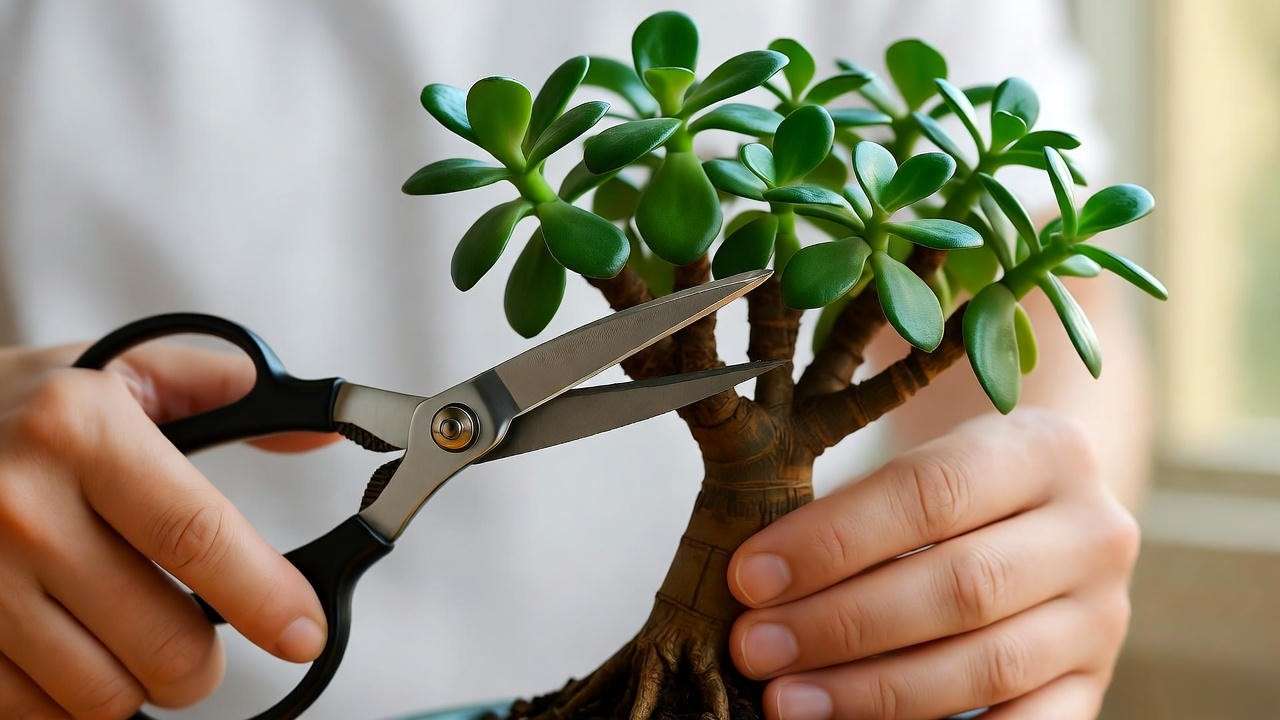
5.2 Wiring and Training
Wiring helps guide branches into your desired bonsai shape. Use soft aluminum wire (1–2 mm thick) and follow these steps:
- Wrap the wire gently around a branch, starting at the base.
- Bend the branch carefully to avoid snapping.
- Leave the wire in place for 2–3 months, checking regularly to prevent it from cutting into the bark.
Safety Tip: Jade branches are brittle, so bend slowly and avoid sharp angles.
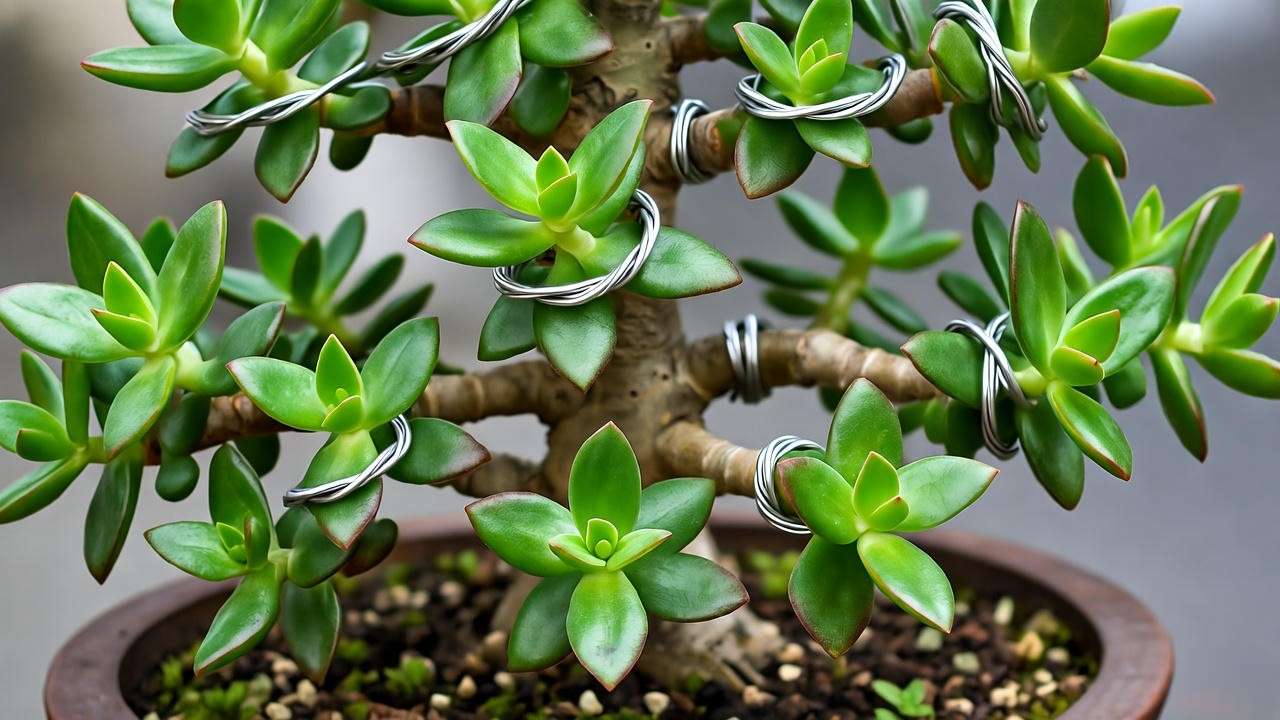
5.3 Repotting Your Jade Bonsai
Repotting keeps your jade bonsai healthy by refreshing the soil and pruning roots. Repot every 2–3 years for young plants or when roots become pot-bound. Here’s how:
- Prepare: Water the plant lightly a day before repotting.
- Remove: Gently lift the plant from its pot and shake off old soil.
- Prune Roots: Trim 20–30% of the roots, focusing on thick, tangled ones.
- Repot: Place in a slightly larger bonsai pot with fresh, well-draining soil.
- Water: Water thoroughly and keep in partial shade for 1–2 weeks.
Choose a shallow, ceramic bonsai pot to enhance the plant’s aesthetic and promote healthy root growth.
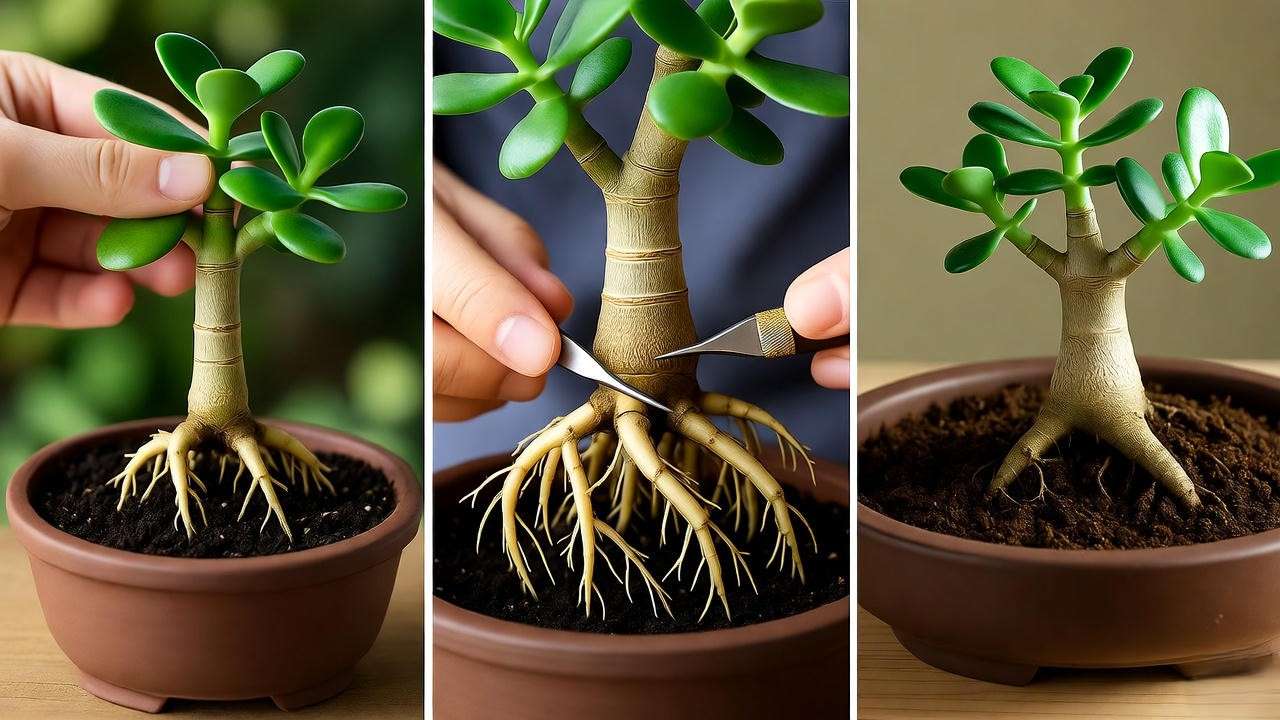
6. Jade Plant Bonsai Care Guide: Daily and Seasonal Tips 🌞
6.1 Light Requirements
Jade bonsai thrive in bright, indirect light or 4–6 hours of direct morning sunlight. Place them near a south-facing window indoors or in a partially shaded outdoor spot. Too little light causes leggy growth, while too much can scorch leaves. Rotate the plant weekly for even exposure. In winter, supplement with a grow light if natural light is limited.
6.2 Watering Best Practices
Jade plants are succulents, so overwatering is their biggest enemy. Use the “soak and dry” method:
- Water thoroughly until it drains from the pot’s holes.
- Wait until the soil is completely dry (usually 1–2 weeks) before watering again.
- Check the soil with your finger or a moisture meter to avoid guesswork.
Signs of Trouble:
- Overwatering: Soft, mushy leaves or root rot.
- Underwatering: Wrinkled, shriveled leaves.
Fix It: Adjust your watering schedule and ensure proper drainage.
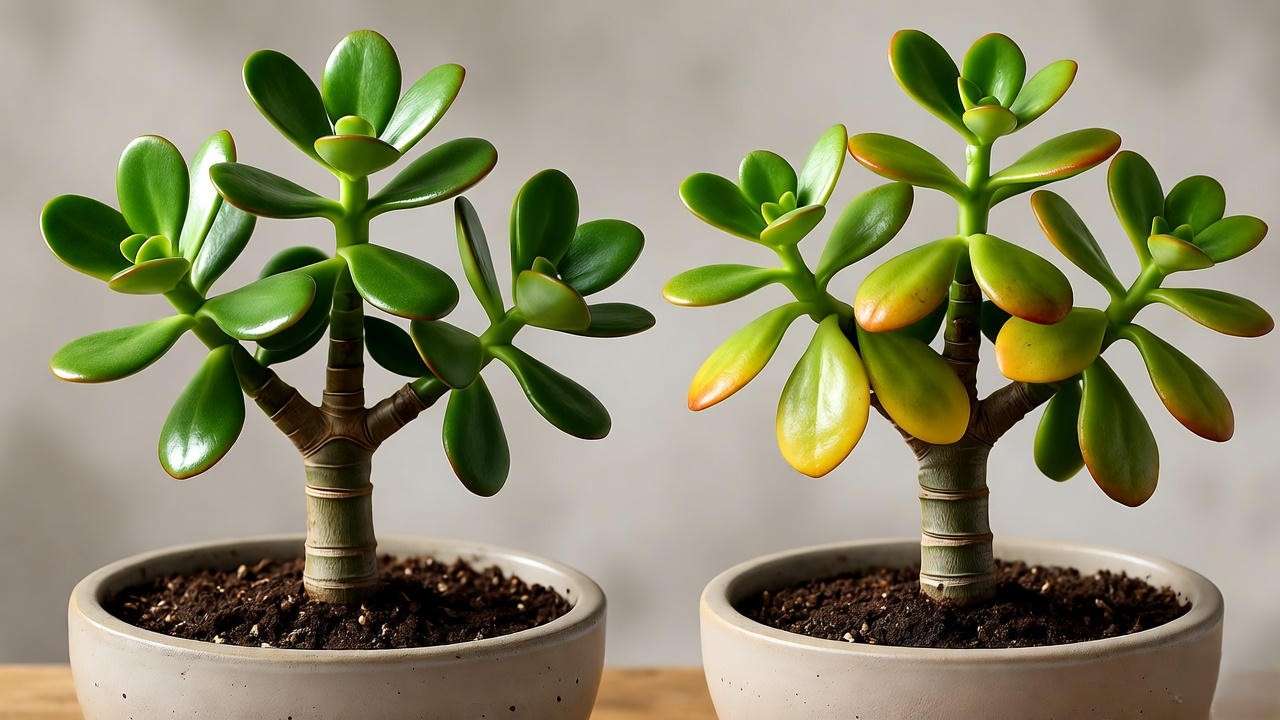
6.3 Soil and Fertilization
Use a well-draining soil mix (e.g., 50% cactus soil, 25% perlite, 25% sand) to prevent waterlogging. Fertilize monthly during spring and summer with a balanced liquid fertilizer (e.g., 10-10-10) diluted to half strength. Skip fertilizing in fall and winter when growth slows.
6.4 Temperature and Humidity
Jade bonsai prefer temperatures between 60–75°F (15–24°C). Protect them from frost or extreme heat. Indoors, maintain moderate humidity (30–50%) using a pebble tray or occasional misting. Avoid placing near drafty windows or heating vents.
7. Common Problems and Solutions for Jade Plant Bonsai 🚑
Caring for a jade plant bonsai is straightforward, but even the hardiest plants can face challenges. Below, we address common issues and provide expert-backed solutions to keep your bonsai thriving.
7.1 Pests and Diseases
Jade plants are relatively pest-resistant, but they can occasionally attract mealybugs, spider mites, or scale.
- Mealybugs: Look for white, cottony masses on leaves or stems. Treat by wiping with a cotton swab dipped in rubbing alcohol or applying neem oil.
- Spider Mites: Tiny webs and stippled leaves are telltale signs. Increase humidity and spray with a mild soap-water solution.
- Scale: Hard, brown bumps on stems. Scrape off gently and apply insecticidal soap.
Prevention: Regularly inspect your bonsai, maintain good airflow, and avoid overwatering to deter pests. Clean tools between uses to prevent disease spread.
7.2 Leaf Drop and Other Issues
Leaf drop is a common concern for jade bonsai owners. Causes include:
- Overwatering: Soggy soil leads to root rot, causing leaves to fall. Reduce watering and ensure proper drainage.
- Underwatering: Wrinkled or shriveled leaves indicate dehydration. Water thoroughly and adjust your schedule.
- Poor Light: Insufficient light causes leggy growth and leaf drop. Move to a brighter spot or use a grow light.
- Stress: Temperature fluctuations or sudden moves can shock the plant. Gradually acclimate it to new conditions.
Expert Insight: To revive a struggling jade bonsai, assess light, water, and soil conditions first. Trim dead leaves, repot if needed, and be patient—jades are resilient!
7.3 Overwatering vs. Underwatering
Distinguishing between overwatering and underwatering is key:
- Overwatering Symptoms: Yellow, mushy leaves; soft, blackened stems; moldy soil.
- Solution: Let soil dry completely, improve drainage, and repot if root rot is present.
- Underwatering Symptoms: Wrinkled, drooping leaves; dry, compacted soil.
- Solution: Water deeply and establish a consistent schedule (every 1–2 weeks, depending on climate).
Pro Tip: Invest in a moisture meter for precise watering. It’s a game-changer for beginners!
8. Seasonal Care for Jade Plant Bonsai 🍂
Jade bonsai care varies by season to match the plant’s growth cycle. Here’s how to adjust:
- Spring and Summer: These are active growing seasons. Increase watering slightly, fertilize monthly, and prune to shape your bonsai. Place outdoors in partial shade if possible, ensuring protection from intense afternoon sun.
- Fall and Winter: Growth slows, so reduce watering to every 2–3 weeks and stop fertilizing. Move indoors if temperatures drop below 50°F (10°C). Place near a bright window to maintain light exposure.
Climate Tip: If you live in a humid or cold region, use a pebble tray or humidifier indoors to mimic the jade’s native arid environment.
9. Advanced Tips for Stunning Jade Plant Bonsai 🌟
Ready to take your jade bonsai to the next level? These advanced techniques will elevate its beauty:
- Encouraging Flowering: Mature jade bonsai can produce small, star-shaped white or pink flowers in late fall or winter. To encourage blooms, provide cooler nights (50–60°F) and ample sunlight during the day. Avoid over-fertilizing, as excess nitrogen can prioritize leaf growth over flowers.
- Multi-Trunk or Forest Style: Create a dramatic effect by propagating multiple cuttings and planting them together in a single pot. Trim and wire to create a cohesive “forest” look, with varying trunk heights for depth.
- Displaying Your Bonsai: Choose a shallow, ceramic bonsai pot in a neutral or earthy tone to complement the jade’s green foliage. Elevate it on a wooden stand or decorative table to showcase its artistry. Rotate the display monthly to ensure even growth.
Expert Insight: Bonsai master John Naka once said, “Bonsai is not about control, but about harmony.” Approach your jade bonsai with patience and creativity to achieve a balanced, natural look.
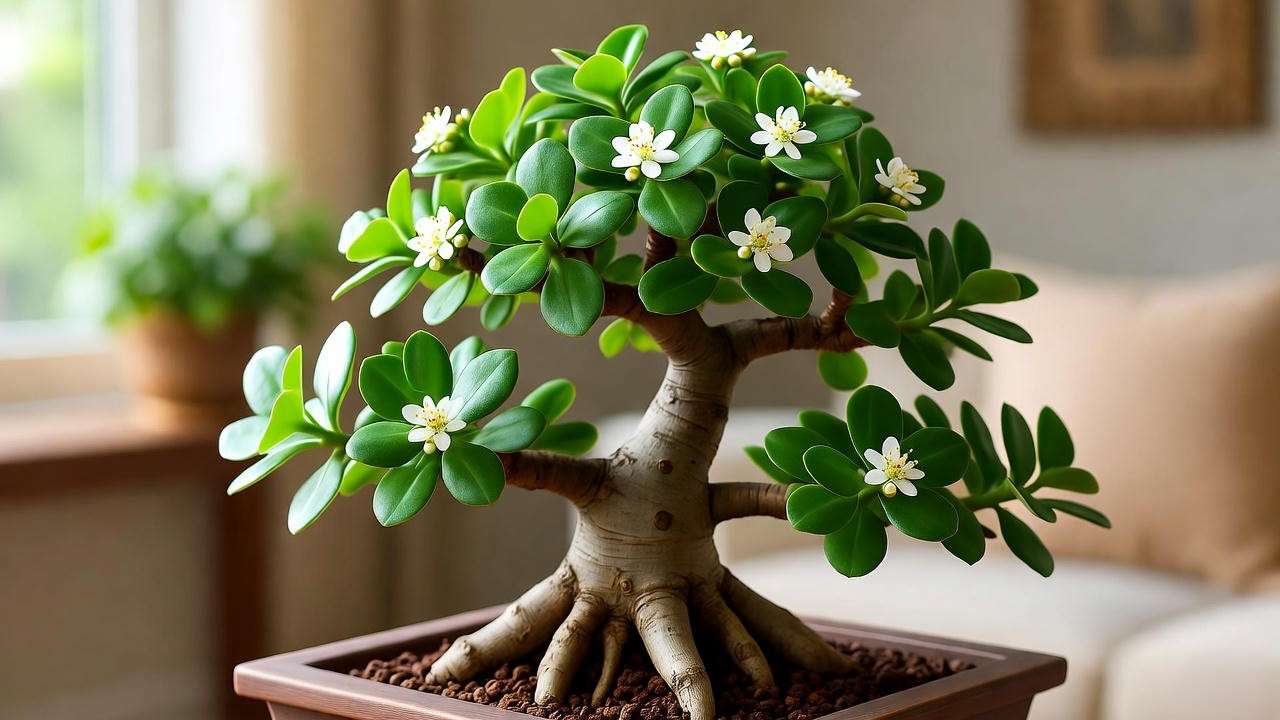
10. FAQs About Jade Plant Bonsai ❓
Here are answers to common questions to help you succeed:
- How long does it take to grow a jade plant bonsai?
A jade bonsai can take 3–5 years to develop a mature, tree-like appearance, but basic shaping can start within months. Patience is key! - Can jade bonsai thrive indoors year-round?
Yes, with bright, indirect light and proper care. Supplement with a grow light in low-light seasons. - What’s the best way to prevent root rot in jade bonsai?
Use well-draining soil, water only when dry, and ensure the pot has drainage holes. - How do I make my jade bonsai look fuller?
Prune regularly to encourage branching, pinch new growth, and ensure adequate light for dense foliage. - Is a jade plant bonsai safe for pets?
Jade plants are mildly toxic to cats and dogs if ingested, causing nausea or lethargy. Keep out of reach or opt for pet-safe plants if concerned.
11. Conclusion: Your Journey to a Thriving Jade Plant Bonsai 🌿
Growing a jade plant bonsai is a rewarding journey that blends horticultural skill with artistic expression. By selecting a healthy plant, mastering pruning and wiring, and providing proper light, water, and care, you can cultivate a stunning miniature tree that brings joy and tranquility to your space. Whether you’re drawn to its lush foliage, symbolic meaning, or low-maintenance nature, your jade bonsai will thrive with the tips in this guide. Start small, experiment with styles, and enjoy the process of nurturing a living work of art.
Ready to begin? Share your jade bonsai progress in the comments or explore our related guides on succulent care and bonsai basics. Happy growing! 🌱

